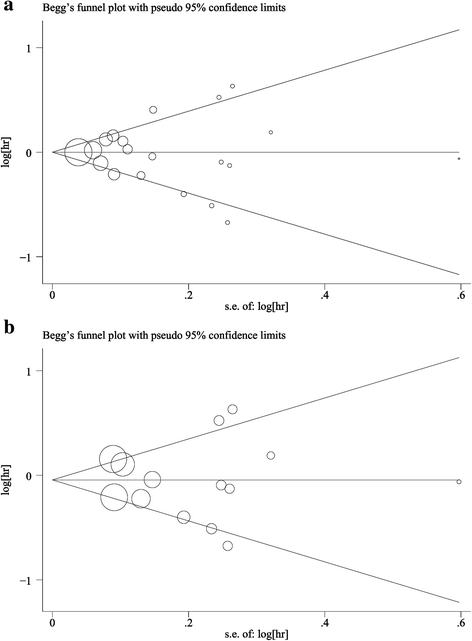Possible association between androgenic alopecia and risk of prostate cancer and testicular germ cell tumor: a systematic review and meta-analysis
- PMID: 29529997
- PMCID: PMC5848631
- DOI: 10.1186/s12885-018-4194-z
Possible association between androgenic alopecia and risk of prostate cancer and testicular germ cell tumor: a systematic review and meta-analysis
Abstract
Background: A number of studies have investigated the association between androgenic alopecia (AGA) and cancer risk, but they have yielded inconsistent results. Therefore, this study was conducted to explore this controversial subject.
Methods: A literature database search was performed according to predefined criteria. An odds ratio (OR) or a hazard ratio (HR) with 95% confidence intervals (CIs) was retained to evaluate the relationship between the incidence of cancer or cancer-specific mortality and categories of AGA. Then a pooled OR or HR was derived.
Results: The pooled results showed that no specific degree of baldness had an influence on the incidence of cancer or cancer-specific mortality. However, AGA, especially frontal baldness, with the incidence of testicular germ cell tumor (TGCT) (OR = 0.69; 95% CI = 0.58-0.83). A significant increase of risk was observed in relation to high grade prostate cancer (PC) (OR = 1.42; 95% CI 1.02-1.99) and vertex with/without frontal baldness was associated with PC risk.
Conclusions: The study results supported the hypothesis that AGA is negatively associated with TGCT risk and suggested an overlapping pathophysiological mechanism between them, while the viewpoint that AGA can be used as a phenotypic marker for PC risk was poorly supported.
Keywords: Androgenic alopecia; Association; Meta-analysis; Prostate cancer; Risk; Testicular germ cell tumor.
Conflict of interest statement
Ethics approval and consent to participate
Not applicable.
Consent for publication
Not applicable.
Competing interests
The authors declare no conflict of interest.
Publisher’s note
Springer Nature remains neutral with regard to jurisdictional claims in published maps and institutional affiliations.
Figures



Similar articles
-
Selenium for preventing cancer.Cochrane Database Syst Rev. 2018 Jan 29;1(1):CD005195. doi: 10.1002/14651858.CD005195.pub4. Cochrane Database Syst Rev. 2018. PMID: 29376219 Free PMC article.
-
Dexrazoxane for preventing or reducing cardiotoxicity in adults and children with cancer receiving anthracyclines.Cochrane Database Syst Rev. 2022 Sep 27;9(9):CD014638. doi: 10.1002/14651858.CD014638.pub2. Cochrane Database Syst Rev. 2022. PMID: 36162822 Free PMC article.
-
A systematic review and economic evaluation of epoetin alpha, epoetin beta and darbepoetin alpha in anaemia associated with cancer, especially that attributable to cancer treatment.Health Technol Assess. 2007 Apr;11(13):1-202, iii-iv. doi: 10.3310/hta11130. Health Technol Assess. 2007. PMID: 17408534
-
A rapid and systematic review of the clinical effectiveness and cost-effectiveness of topotecan for ovarian cancer.Health Technol Assess. 2001;5(28):1-110. doi: 10.3310/hta5280. Health Technol Assess. 2001. PMID: 11701100
-
Home treatment for mental health problems: a systematic review.Health Technol Assess. 2001;5(15):1-139. doi: 10.3310/hta5150. Health Technol Assess. 2001. PMID: 11532236
Cited by
-
Comorbidities in Androgenetic Alopecia: A Comprehensive Review.Dermatol Ther (Heidelb). 2022 Oct;12(10):2233-2247. doi: 10.1007/s13555-022-00799-7. Epub 2022 Sep 17. Dermatol Ther (Heidelb). 2022. PMID: 36115913 Free PMC article. Review.
-
Does androgenic alopecia aggravate the risk of prostate cancer? Evidence from Mendelian randomization.Prostate Int. 2024 Jun;12(2):110-115. doi: 10.1016/j.prnil.2024.04.001. Epub 2024 Apr 19. Prostate Int. 2024. PMID: 39036755 Free PMC article.
-
Risk factors for prostate cancer: An umbrella review of prospective observational studies and mendelian randomization analyses.PLoS Med. 2024 Mar 15;21(3):e1004362. doi: 10.1371/journal.pmed.1004362. eCollection 2024 Mar. PLoS Med. 2024. PMID: 38489391 Free PMC article.
-
2022 Update on Prostate Cancer Epidemiology and Risk Factors-A Systematic Review.Eur Urol. 2023 Aug;84(2):191-206. doi: 10.1016/j.eururo.2023.04.021. Epub 2023 May 16. Eur Urol. 2023. PMID: 37202314 Free PMC article.
-
mRNA Levels of Aromatase, 5α-Reductase Isozymes, and Prostate Cancer-Related Genes in Plucked Hair from Young Men with Androgenic Alopecia.Int J Mol Sci. 2023 Dec 14;24(24):17461. doi: 10.3390/ijms242417461. Int J Mol Sci. 2023. PMID: 38139289 Free PMC article.
References
-
- Piraccini B, Alessandrini A. Androgenetic alopecia. G Ital Dermatol Venereol. 2014;149(1):15–24. - PubMed
Publication types
MeSH terms
Supplementary concepts
Grants and funding
LinkOut - more resources
Full Text Sources
Other Literature Sources
Medical
Miscellaneous

